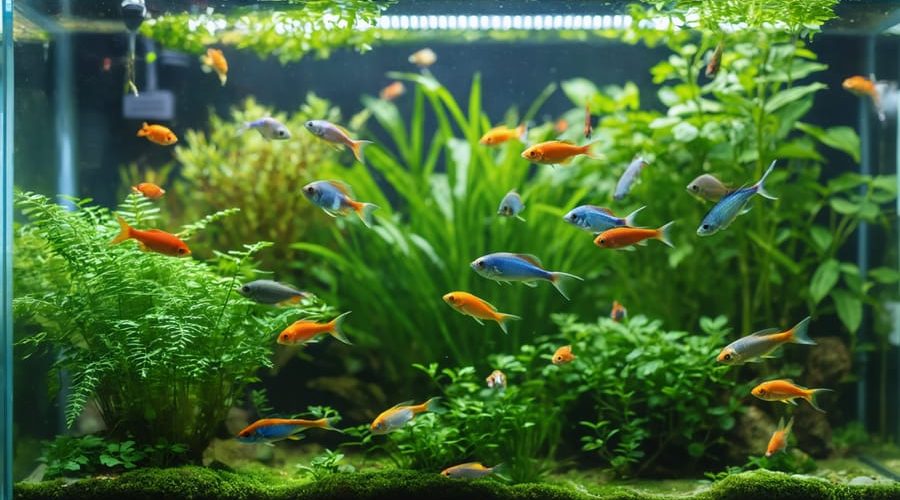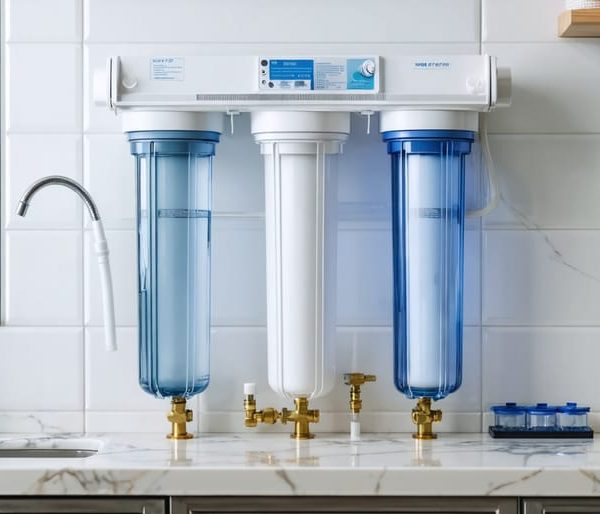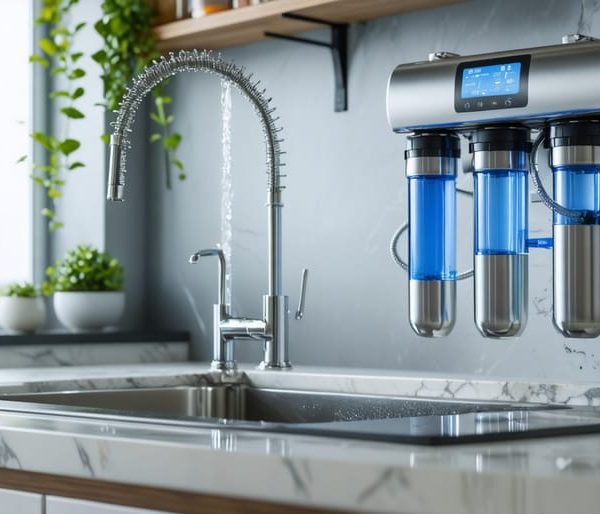Aquarium water transforms ordinary houseplants into thriving green specimens, thanks to its rich blend of beneficial nutrients and organic matter. This natural fertilizer contains fish waste, beneficial bacteria, and trace elements that commercial plant foods often lack. While many gardeners pay premium prices for specialized fertilizers, aquarium owners sit on a goldmine of free, nutrient-dense water that can revolutionize plant growth.
The secret lies in the aquarium’s unique ecosystem: fish produce nitrogen-rich waste, beneficial bacteria convert it into plant-available nutrients, and microscopic organisms create a living soup of growth-promoting compounds. This natural cycle mirrors the relationships found in natural waterways, where aquatic life supports lush riverside vegetation. For indoor and outdoor plants alike, this nutrient-rich water provides a balanced feast of essential elements, promoting stronger root systems, vibrant foliage, and improved resistance to disease.
However, understanding when and how to use aquarium water on plants makes the difference between success and potential problems. Factors like salt content, medication presence, and algae levels all play crucial roles in determining whether your aquarium water will benefit or harm your plants.
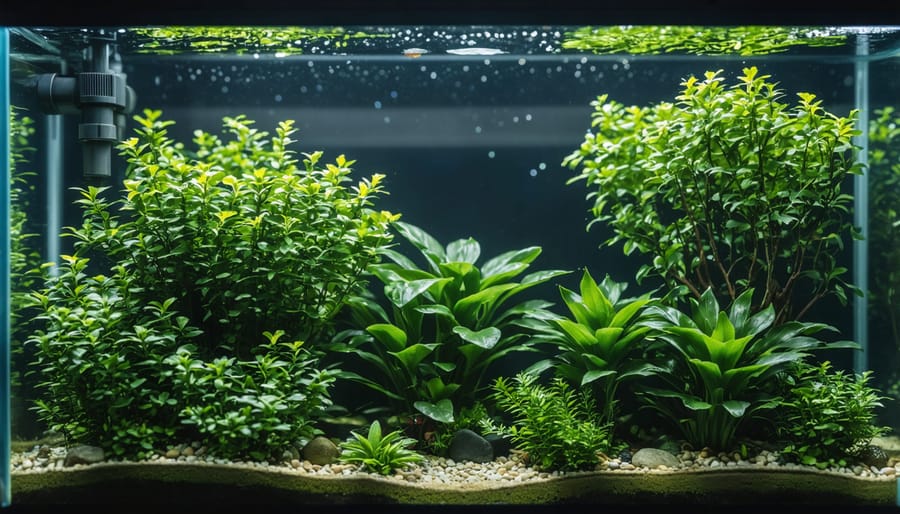
The Natural Benefits of Aquarium Water for Plants
Nitrogen-Rich Goodness
One of the most valuable components of aquarium water is its rich nitrogen content, primarily derived from fish waste. As fish produce waste, beneficial bacteria in the aquarium break it down into various nitrogen compounds, including nitrates, which are essential nutrients for plant growth. This natural process creates a nutrient-rich solution that plants readily absorb.
Fish waste contains ammonia, which beneficial bacteria convert into nitrites and then into nitrates through the nitrogen cycle. While high levels of ammonia and nitrites can be harmful to fish, the end product – nitrates – is exactly what plants need for healthy growth, particularly for developing lush, green foliage.
Think of aquarium water as a natural, free fertilizer. The nitrogen content helps stimulate leaf growth, improve chlorophyll production, and enhance overall plant vigor. This makes it especially beneficial for leafy plants like vegetables, herbs, and ornamental plants that require significant nitrogen for proper development.
However, it’s important to note that the nitrogen concentration can vary depending on factors such as the number of fish, feeding habits, and tank maintenance schedule.
Beneficial Bacteria and Microorganisms
Aquarium water is teeming with beneficial microorganisms that can significantly enhance plant growth. These helpful bacteria, primarily consisting of nitrifying bacteria like Nitrosomonas and Nitrobacter, play a crucial role in breaking down fish waste and organic matter into nutrients that plants can readily absorb. Through the nitrogen cycle, these microbes convert ammonia from fish waste into nitrites and then into nitrates, which serve as a natural fertilizer for plants.
Additionally, aquarium water contains various beneficial protozoans and other microscopic organisms that help maintain healthy soil biology. These microorganisms can improve soil structure, enhance nutrient absorption, and strengthen plants’ natural defense systems against diseases. The diverse microbial community in aquarium water can also help establish beneficial relationships with plant roots, similar to what occurs in natural ecosystems.
When you water plants with aquarium water, you’re essentially introducing a living ecosystem that can continue to benefit your plants long after watering. This natural probiotic effect makes aquarium water particularly valuable for organic gardening and sustainable plant care practices.
Trace Elements and Minerals
Aquarium water contains valuable trace elements and minerals from various sources, particularly fish food and supplements. As fish consume their food, they release nutrients into the water through waste products. These nutrients include essential elements like iron, zinc, and magnesium, which are beneficial for plant growth. The water hardness and mineral content are often enhanced by aquarium supplements added for fish health, creating a nutrient-rich solution for plants. Regular water testing can help monitor TDS levels in aquarium water, ensuring optimal mineral concentrations for both aquatic life and plants. Many aquarists use supplements containing trace elements like copper, manganese, and molybdenum, which can provide additional nutritional benefits when the water is used for watering plants.
When to Use (and When to Avoid) Aquarium Water
Ideal Plant Candidates
Several plant types thrive particularly well when watered with aquarium water. Leafy vegetables like lettuce, kale, and spinach respond excellently to the nitrogen-rich water, making it perfect for vegetable gardens. Heavy feeders such as tomatoes, cucumbers, and squash benefit greatly from the additional nutrients found in fish water.
Houseplants that love high-nitrogen environments, including pothos, philodendrons, and peace lilies, show remarkable growth when given aquarium water. These plants are particularly good at utilizing the dissolved nutrients and often display more vibrant foliage as a result.
Moisture-loving plants like ferns, calatheas, and prayer plants appreciate both the nutrients and the natural minerals present in aquarium water. Herbs such as basil, mint, and parsley also show excellent growth when watered with aquarium water, often developing stronger flavors and more abundant foliage.
For outdoor gardens, roses and other flowering plants can benefit from the phosphorus content in aquarium water, which helps promote better blooming and stronger root development. Even acid-loving plants like azaleas and gardenias can thrive with aquarium water, especially if your tank contains driftwood that slightly lowers the pH.
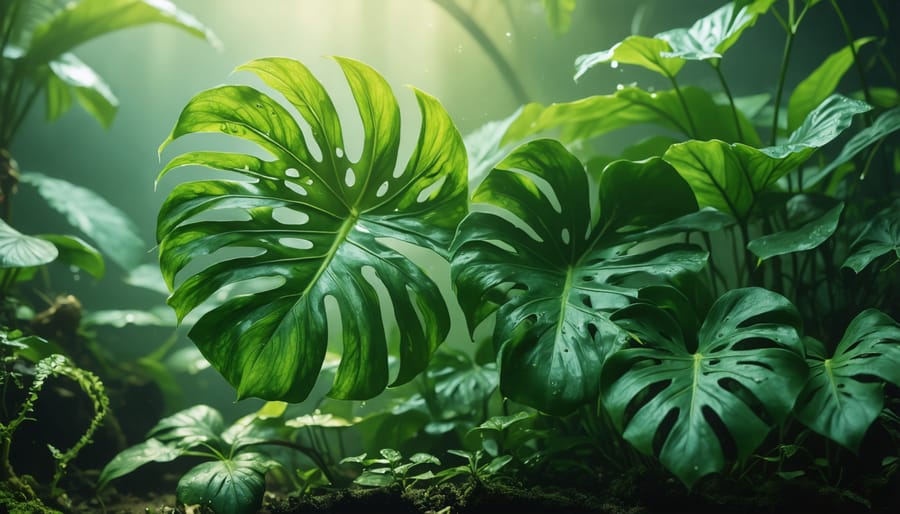
Warning Signs and Precautions
While aquarium water can benefit plants, there are important warning signs to watch for before using it. If your fish tank shows signs of disease, medication residue, or algal blooms, avoid using this water on your plants as it could transfer harmful substances or pathogens. It’s crucial to regularly test aquarium water quality to ensure it’s safe for both fish and plants.
Be cautious if you notice unusual colors, strong odors, or excessive cloudiness in your tank water. These could indicate high levels of ammonia, nitrites, or other compounds that might harm your plants. If you’ve recently treated your aquarium with medications, wait at least two weeks before using the water for plants, as some treatments can persist in the water and potentially damage plant tissue.
Salt water aquariums are generally unsuitable for watering plants, as most houseplants and garden plants cannot tolerate high salt concentrations. Additionally, if your aquarium contains artificial decorations that leach chemicals, or if you use water conditioners containing copper, these elements could accumulate in your soil and potentially harm your plants over time.
Watch your plants for signs of stress after applying aquarium water. If you notice leaf yellowing, wilting, or stunted growth, discontinue use immediately. Some sensitive plants may react negatively to the nutrients or bacterial composition of aquarium water, so it’s wise to test on a single plant first before widespread application.
Best Practices for Using Aquarium Water
Collection and Storage Methods
Collecting aquarium water for plants requires proper timing and methods to ensure both your aquatic pets and plants benefit. The best time to collect water is during routine water changes, typically every 2-4 weeks, when you’re already removing water to maintain your aquarium’s health. Similar to how effects of tap water on fish can be harmful, proper collection and storage methods are crucial for plant health.
Use a clean bucket or container specifically designated for aquarium water collection. Avoid containers that have previously held chemicals or cleaning products. When collecting, use a siphon or pump to remove water, making sure to avoid disturbing the substrate too much, which can make the water too murky.
For storage, use food-grade plastic containers with secure lids to prevent contamination. Store the water at room temperature and away from direct sunlight to prevent algae growth. While aquarium water can be stored for up to 24 hours, it’s best to use it immediately for optimal nutrient benefits.
Label your storage containers with the collection date and avoid storing for extended periods. If you notice any unusual odors or cloudiness in stored water, it’s better to discard it and collect fresh water during the next aquarium maintenance session.
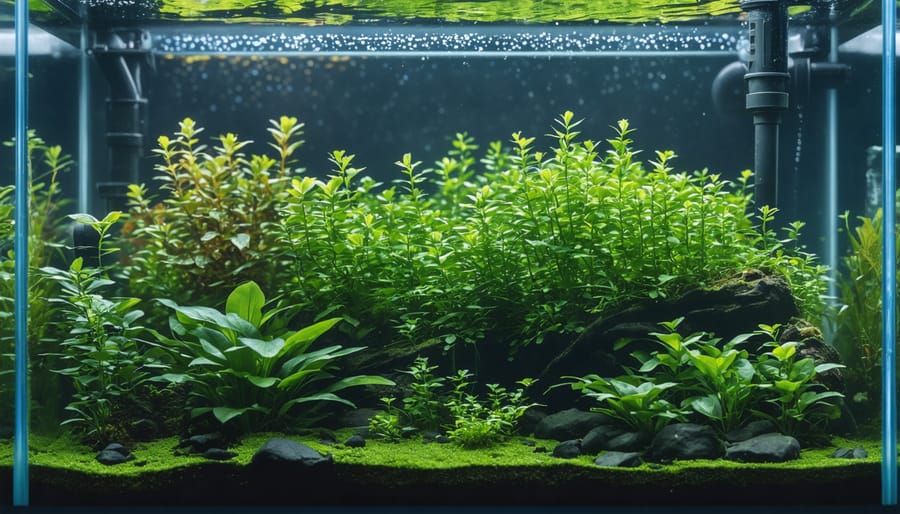
Application Techniques
When using aquarium water for plants, proper application techniques are essential for the best results. For indoor plants, gently pour the water directly into the pot’s soil, ensuring even distribution and avoiding splashing on leaves. Use a watering can or clean container to filter out any debris that might clog soil pores.
For outdoor gardens, apply aquarium water at the base of plants during early morning or late evening to prevent rapid evaporation. This timing allows roots to absorb maximum nutrients. For larger garden areas, dilute the aquarium water with regular water in a 1:1 ratio to extend coverage while maintaining benefits.
Foliar feeding, or spraying aquarium water directly on plant leaves, can be effective for some plants but should be done sparingly and only with clear, debris-free water. When watering seedlings or delicate plants, use aquarium water at half strength to prevent overwhelming young roots.
Frequency matters too – alternate between aquarium water and regular water to prevent potential mineral buildup in the soil. During water changes, collect the water in clean containers and use it within 24 hours for optimal nutrient content.
Frequency and Timing
For optimal results, use aquarium water on your plants every 1-2 weeks during regular tank maintenance. When performing a partial water change, which typically involves replacing 10-25% of the tank water, use this nutrient-rich water immediately on your plants for the best benefits. If you can’t use it right away, store it for up to 24 hours in a covered container at room temperature.
During the growing season (spring and summer), you can increase the frequency to weekly applications, as plants have higher nutrient demands during this period. In winter, reduce the frequency to every 2-3 weeks since both plant growth and fish waste production typically slow down.
Be mindful not to oversaturate your plants. While aquarium water is beneficial, your plants still need their soil to dry slightly between watering sessions. For indoor plants, combine aquarium water with regular watering schedules, using tank water for about half of your plant’s watering needs. For outdoor gardens, you can be more liberal with application, especially during dry spells.
If you notice any signs of salt buildup or mineral deposits on your plants’ soil, reduce the frequency of aquarium water applications and alternate with fresh water.
Using aquarium water for plants represents a sustainable and resourceful approach to both plant care and water conservation. Throughout this exploration, we’ve discovered that aquarium water contains valuable nutrients, beneficial bacteria, and organic matter that can significantly enhance plant growth and soil health. The nitrogen-rich water, particularly from established aquariums, serves as a natural fertilizer that can boost plant development without the need for additional chemical supplements.
When implementing this eco-friendly practice, remember to follow the key guidelines we’ve discussed. Always use water from healthy, well-maintained aquariums, and avoid water from tanks that have been recently medicated or show signs of disease. For best results, use the water immediately after collection during your regular tank maintenance routine, and apply it to your plants’ soil rather than spraying it on leaves.
Different plants respond differently to aquarium water, with most houseplants, vegetable gardens, and outdoor ornamental plants showing positive results. However, it’s essential to monitor your plants’ response and adjust the frequency of application accordingly. Start with a small test area before implementing this practice broadly across your garden.
The environmental benefits of using aquarium water extend beyond plant health. This practice reduces water waste, decreases the need for synthetic fertilizers, and creates a closed-loop system within your household. It’s a perfect example of how simple, thoughtful actions can contribute to more sustainable living practices.
To maximize the benefits, maintain regular aquarium cleaning schedules, ensure proper fish stocking levels, and keep your tank parameters stable. This will guarantee that the water you’re using for your plants is of the highest quality and contains the optimal balance of nutrients.
By incorporating aquarium water into your plant care routine, you’re not just nurturing healthier plants – you’re participating in an environmentally conscious practice that benefits both your indoor and outdoor ecosystems while reducing your environmental footprint.
